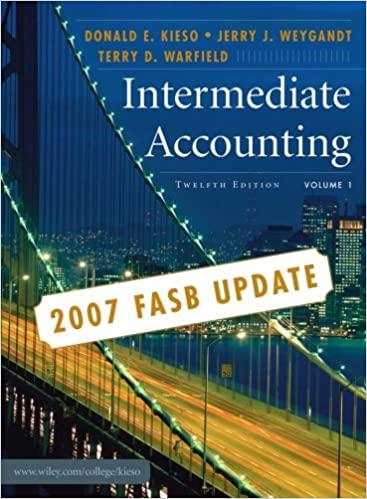Question
As you learned in the previous chapters, Current Designs has two main product linescomposite kayaks, which are handmade and very labor-intensive, and rotomolded kayaks, which
As you learned in the previous chapters, Current Designs has two main product linescomposite kayaks, which are handmade and very labor-intensive, and rotomolded kayaks, which require less labor but employ more expensive equipment. Current Designs controller, Diane Buswell, is now evaluating several different methods of assigning overhead to these products. It is important to ensure that costs are appropriately assigned to the companys products. At the same time, the system that is used must not be so complex that its costs are greater than its benefits. Diane has decided to use the following activities and costs to evaluate the methods of assigning overhead.
| Activities | Cost | |
|---|---|---|
| Designing new models | $ 124,000 | |
| Creating and testing prototypes | 160,000 | |
| Creating molds for kayaks | 196,000 | |
| Operating oven for the rotomolded kayaks | 36,000 | |
| Operating the vacuum line for the composite kayaks | 28,000 | |
| Supervising production employees | 168,000 | |
| Curing time (the time that is needed for the chemical processes to finish before the next step in the production process; many of these costs are related to the space required in the building) | 170,000 | |
| Total | $ 882,000 |
As Diane examines the data, she decides that the cost of operating the oven for the rotomolded kayaks and the cost of operating the vacuum line for the composite kayaks can be directly assigned to each of these product lines and do not need to be assigned with the other costs. For purposes of this analysis, assume that Current Designs uses $ 241,000 in direct labor costs to produce 1,000 composite kayaks and $ 270,250 in direct labor costs to produce 4,000 rotomolded kayaks each year.
(a)
New attempt is in progress. Some of the new entries may impact the last attempt grading.
Your answer is incorrect.
One method of assigning overhead would assign the common costs to each product line by using an assignment basis such as the number of employees working on each type of kayak or the amount of factory space used for the production of each type of kayak. Diane knows that about 50% of the area of the plant and 50% of the employees work on the composite kayaks, and the remaining space and other employees work on the rotomolded kayaks. Using this information and remembering that the costs of operating the oven and vacuum line have been directly assigned, determine the total amount to be assigned to the composite kayak line and the rotomolded kayak line, and the amount to be assigned to each of the units in each line. (Round cost assigned per unit to 2 decimal places, e.g. 125.25.)
| Composite | Rotomolded | |||
|---|---|---|---|---|
| Total cost assigned | $ enter a dollar amount | $ enter a dollar amount | ||
| Cost assigned per unit | $ enter a dollar amount rounded to 2 decimal places | $ enter a dollar amount rounded to 2 decimal places |
eTextbook and Media
Save for Later
Attempts: 1 of 3 used
Submit Answer
Using multiple attempts will impact your score.
10% score reduction after attempt 2
(b)
Another method of assigning overhead is to use direct labor dollars as an assignment basis. Remembering that the costs of the oven and the vacuum line have been assigned directly to the product lines, allocate the remaining costs using direct labor dollars as the allocation basis. Then, determine the amount of overhead that should be assigned to each unit of each product line using this method. (Round cost assigned per unit to 2 decimal places, e.g. 125.25.)
| Composite | Rotomolded | |||
|---|---|---|---|---|
| Total cost assigned | $ enter a dollar amount | $ enter a dollar amount | ||
| Cost assigned per unit | $ enter a dollar amount rounded to 2 decimal places | $ enter a dollar amount rounded to 2 decimal places |
eTextbook and Media
Save for Later
Attempts: 0 of 3 used
Submit Answer
Using multiple attempts will impact your score.
10% score reduction after attempt 2
(c)
Activity-based costing requires a cost driver for each cost pool. Use the following information to assign the costs to the product lines using the activity-based costing approach.
| Activity Cost Pools | Cost Drivers | Driver Amount for Composite Kayaks | Driver Amount for Rotomolded Kayaks | |||||
|---|---|---|---|---|---|---|---|---|
| Designing new models | Number of models | 3 | 1 | |||||
| Creating and testing prototypes | Number of prototypes | 6 | 2 | |||||
| Creating molds for kayaks | Number of molds | 13 | 1 | |||||
| Supervising production employees | Number of employees | 11 | 13 | |||||
| Curing time | Number of days of curing time | 15,000 | 2,000 | |||||
What amount of overhead should be assigned to each composite kayak using this method? What amount of overhead should be assigned to each rotomolded kayak using this method? (Round cost assigned per unit to 2 decimal places, e.g. 125.25.)
| Composite | Rotomolded | |||
|---|---|---|---|---|
| Total cost assigned | $ enter a dollar amount | $ enter a dollar amount | ||
| Cost assigned per unit | $ enter a dollar amount rounded to 2 decimal places | $ enter a dollar amount rounded to 2 decimal places |
Step by Step Solution
There are 3 Steps involved in it
Step: 1

Get Instant Access to Expert-Tailored Solutions
See step-by-step solutions with expert insights and AI powered tools for academic success
Step: 2

Step: 3

Ace Your Homework with AI
Get the answers you need in no time with our AI-driven, step-by-step assistance
Get Started


